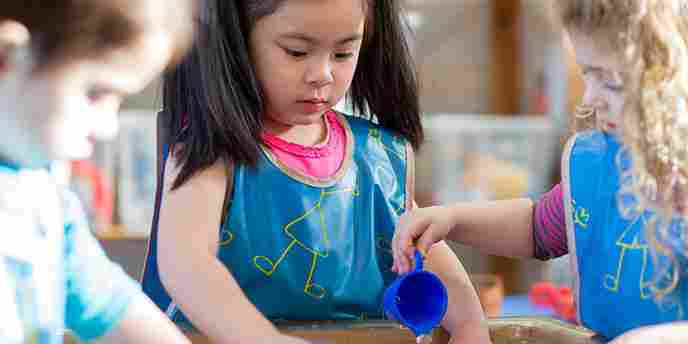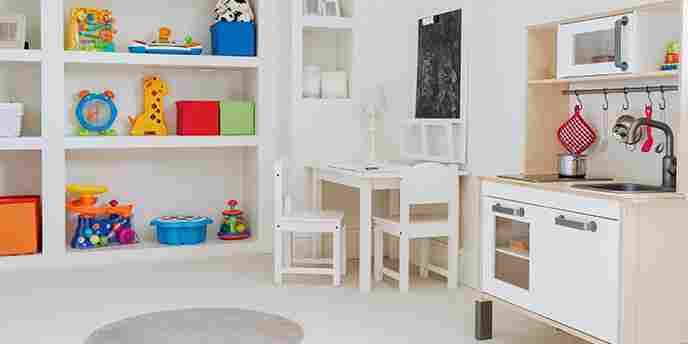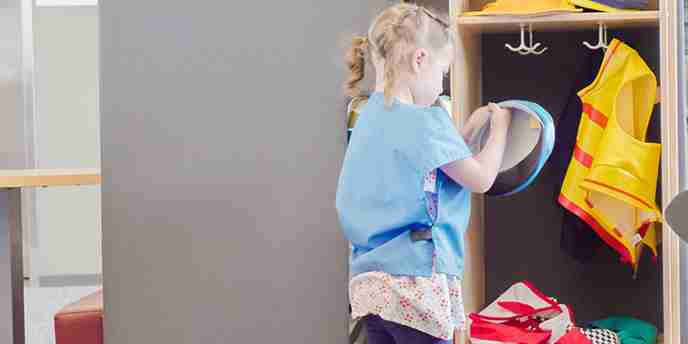Kid-Friendly Basement Ideas for All Ages
As the weather turns cold and snow becomes imminent, you might find your children getting restless indoors. When it’s too cold to play outside, your kids will most likely need to find a different way to release their energy and creativity. A good solution to keep the whole family sane is to give them a designated section of the house to keep their bodies and imaginations active.
9 DIY Basement Playroom Designs
Before jumping into your playroom design, if you have a totally unfinished basement, check out how to finish your basement to make the conversion into a playroom easier. Keeping colors and themes easily transitional will make it simpler to keep the space updated as your children get older.

1. Sensory Play Table
Age Group: 0-3 Years Old
Having a sensory table is a great kid-friendly basement idea to introduce younger children to all the different textures of the world. It also gives them many opportunities to work on their motor skills, improve their concentration and have fun getting messy in the process.
If you have carpet in your basement, you will want to consider a foam, washable playmat to put under the table in case of any spills. You could also place the table inside a plastic baby pool to keep potential spills more contained. For the table itself, you can use an outdoor water table or take a stab at building your own .
There are many different ways your little ones can use the table, from filling it with bubbly water and some bath toys, to dying cooked spaghetti for rainbow sensory fun. This table can get a few years of use since babies and toddlers alike will love to use their imagination and get a little dirty at the same time.

2. Cooking and Kitchen Play Area
Age Group: 1-5 Years Old
They say imitation is the best form of flattery, but it can also play an important part in your child’s development. A play kitchen is a top playroom idea for toddlers that allows them to mimic your everyday activities and can keep them occupied for hours. Plus, it keeps them away from screens and encourages them to use imaginative play, exercise their vocabulary and practice their motor skills.
Load your kitchen with play food, utensils and accessories and watch your child’s imagination go wild.

3. Dress-Up Station
Age Group: 2-10 Years Old
Another fun way to encourage unstructured play for kids in your DIY basement playroom is to provide a place to play dress-up. You can transform a small corner of the basement into a dress-up corner , which easily can be cleaned up and the space can be transitioned to something else when the kids outgrow it.
All you’ll need is a standard full-length mirror (secured or anchored to the wall) and a few adhesive, non-damaging wall hooks to hang construction vests, pith helmets or any other outfits your children might love. Or if you don’t want to stick anything to your wall, you simply can use a chest or storage bins.
Old Halloween costumes, hats and accessories can all find additional use here. You can also check your local thrift stores to find more pieces to add. Make sure to choose items that can easily be taken on and off.
4. DIY Climbing Wall
Age Group: 3-10 Years Old
To keep your kids from climbing the walls (or your furniture) from boredom, a DIY basement climbing wall might be the solution. If you’re feeling handy, these are a great way for your kids to expend some of their energy and get some exercise while stuck inside.
You’ll just need a clear corner of the basement, a folding gymnastics mat, some plywood, a few tools and climbing holds. Because this is in the basement, the shorter wall height makes it safe for even your young toddlers. It’s a great activity for supervised fun and an exciting activity for your kids to do with their friends.
5. Media Corner
Age Group: 5-18 Years Old
Movie night anyone? This idea is perfect for all ages and may be the area of the basement you won’t need to transition as your kiddos grow up. All you’ll need is a big, comfortable couch, an entertainment center and your TV.
For additional teenage hangout area ideas, you could also include any gaming systems that are popular in your household. And make sure to use some of the storage space in your entertainment center to keep some family-friendly board games for an impromptu game night.
6. Homework Station
Age Group: 5-18 Years Old
This area will be important as soon as your kids hit kindergarten age. The last thing they’ll want to do when they get home from school is more school work, but if you create a fun, cozy space for them do it in, you may get less of a fuss. Plus, you’ll be helping them learn time management and organization skills.
You’ll need an age appropriate desk or table with chairs, a dry erase board, supply caddy and a lamp if your basement is dimly lit. If possible, choose a spot near a window for some natural light. You will also want to make sure the desk is set up near outlets in case your child needs access to their tablet or laptop to complete their assignments.
7. Reading Nook
Age Group: All Ages
Creating a cozy spot in your basement for a reading nook is a great way to encourage quiet time and can be used by kids of any age – maybe even parents, too!
To create your reading space, you’ll need a lamp, some bean bag chairs or comfortable armchairs and a bookshelf. You could also go the minimalist route with a soft rug and oversize pillows. No matter what you choose to decorate with, creating a comfortable reading spot will allow your kids to fall in love with the world of books, get their imaginations wandering and maybe introduce them to the hygge lifestyle.
8. Craft Table
Age Group: All Ages
Setting up an arts and craft corner of the basement will allow your little ones’ imaginations to run wild. You can use the same table as the homework station, but only if your children can understand that homework comes before playtime and crafts so you can avoid regular tantrums. It can be as simple as adding some stackable storage bins to organize your supplies and buying a second caddy for paintbrushes, scissors, glue, etc.
While a craft table is a great way to give your kids a sense of independence, be careful – too much independence here can lead to your walls becoming their canvas. For littler ones, make sure that messy craft supplies are stored properly and out of reach to prevent any major mishaps.
9. Chalkboard Wall
Age Group: All Ages
A chalkboard wall can be incorporated into other basement playroom ideas, such as your homework station or crafting area. It can be useful for the littlest of your children to practice writing their numbers and letters or even be a fun way for friends and family to leave notes for each other.
You can purchase chalkboard contact paper to stick on the wall of your choice, or paint an entire wall or section of a wall with chalkboard paint.
Basement Safety Checklist
Before you begin these transformative playroom projects, it’s important to thoroughly declutter the space and make sure your basement is safe for babies, toddlers and children alike.
Waterproof and Check for Mold
Before you invest time and money into a basement hangout for the kiddos, you’ll want to make sure it’s waterproof and safe from any mold or water damage.
Keep Hazardous Items Out of Reach
Your basement can contain a lot of hazardous materials, whether it’s detergent and bleach for laundry or sharp tools in your workshop. You’ll want to make sure all of these things are on high shelves out of reach or in locked cabinets.
“Don’t leave any chemicals out in your basement. Extreme humidity, heat and weathering can make chemicals very dangerous. And keep chemicals and valuables off the ground in case of flooding or water leaks. Child-proof your basement with safety locks on cabinets and doors that have hazardous chemicals and sharp objects.”
Dashia Starr | ADT
Anchor All Shelving and Storage
Just like with any large pieces of furniture, it’s a good idea to anchor any shelving or entertainment centers to the wall to prevent them from tipping over.
Seal Electrical Outlets
For outlets that are not in use, you can use plastic outlet plug covers. For outlets that do have devices plugged in, you can purchase an outlet or power strip cover box.
Ensure Staircase Safety
Make sure your staircase has a railing and baby gates installed at the top and bottom of your stairs if your child is smaller and not ready to go up and down the staircase alone.
“Add lighting and sturdy railing to your stairway to safely access your basement. And, if you have kids or pets, consider adding a gate for their safety. Lastly, don’t place any objects or cords on the stairway as they may be tripping hazards.”
Dashia Starr | ADT
Create an Exit Strategy in Case of Emergency
The whole family should be informed of your exit strategy if an emergency such a as a fire were to happen. Make sure your basement windows can open easily and lock securely.
Install Smoke Alarms and Carbon Monoxide Detectors
Your basement should be equipped with its own smoke and carbon monoxide detectors. Test the alarms and make a note of when you last replaced the batteries.
“Make sure you have both, a carbon monoxide detector and smoke detector, on each floor of your home – including your attic, basement and garage. It’s best to get detectors that are professionally monitored by a home security provider just in case you’re away. If the detectors are triggered, your security provider will send emergency responders to your home for your safety.”
Dashia Starr | ADT
Other Basement Projects to Tackle
If you’re looking for more ways to use the space in your basement, check out these posts to help give you some additional ideas:
Your comment